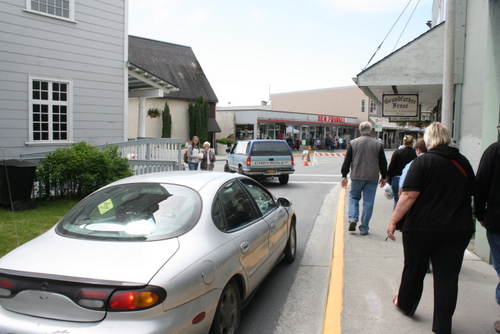
Traffic makes its way around St. Michael’s Russian Orthodox Cathedral, avoiding an area of downtown designated as pedestrian only for part of Wednesday. Some motorists said the closure was a major inconvenience, and the city has temporarily suspended the plan until the Assembly can make a decision. (KCAW photo by Ed Ronco)
A portion of downtown Sitka will not be closed to vehicles for the next couple Wednesdays, despite previous plans. A group hoping to improve the look and feel of Sitka’s downtown was trying to see if a pedestrian mall might boost commerce along Lincoln Street. But the city temporarily suspended the street closures on Monday, until the Assembly has a chance to discuss the issue.
Usually, you don’t need the Assembly’s approval to close a city street. Take parades, for example: You go to the police department at least 15 days beforehand, pay $50, and well, that’s it, really.
But Interim City Administrator Jay Sweeney says this situation is different, for two reasons:
“The length of time, and the fact that it is closed basically to encourage utilization of the main street corridor for entertainment and or merchandising purposes,” he said.
Sweeney says parades are pretty straightforward. So is the Running of the Boots when Lincoln Street is closed for runners and free food, or Halloween, when the streets are shut down to give candy to children. But he says the pedestrian mall — involving merchants — requires the city to make some decisions.
“For example: The closure plans, as they exist now, close half of downtown,” he said. “So questions have come up from merchants and others who are located outside the barricaded area. ‘Can I come inside the barricaded area? If so, where do I set up? Who is going to assign what spaces? Who is going to monitor who can and cannot be inside those areas?’”
Three more street closures had been planned: June 19, June 26 and July 3. The last one, July 3rd, is still on the calendar. Sweeney’s suspension only affects the next two.
“I don’t know, I guess I’m glad more people are getting involved,” said Cyndy Gibson, one of the volunteers with the Downtown Revitalization group. She coordinated the street closures, and says the delay is not a setback, but rather part of the learning process.
“I’d like to try it again, but if it doesn’t work — if we can’t make it work for everybody — then it’s not fair,” she said. “I don’t want to do something that’s not fair. There were many things I didn’t understand or know when we embarked on this that are still unfolding.”
The closure on June 12 brought lots of feedback. Some merchants said they loved it, others said they felt left out. Our initial story on the closure generated a handful of comments on Facebook and on our own website. Some people praised the Revitalization Group for giving it a try. Others said it was an inconvenience to motorists, and put the interests of visitors and merchants over the needs of residents.
Sweeney, with the city, says the Assembly hopes to hear from the public when it takes up the issue on its next agenda. That will happen at the regular Assembly meeting at 6 p.m. June 25.































